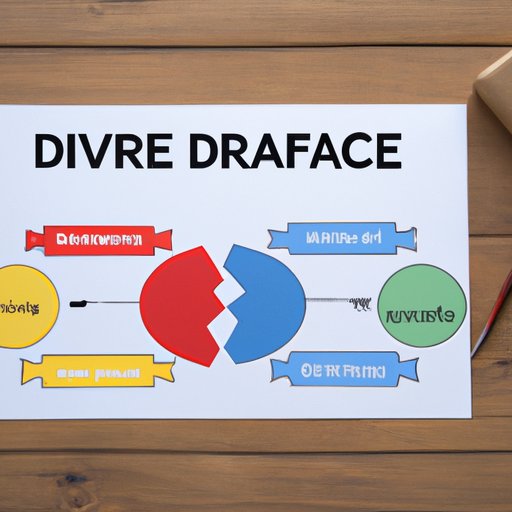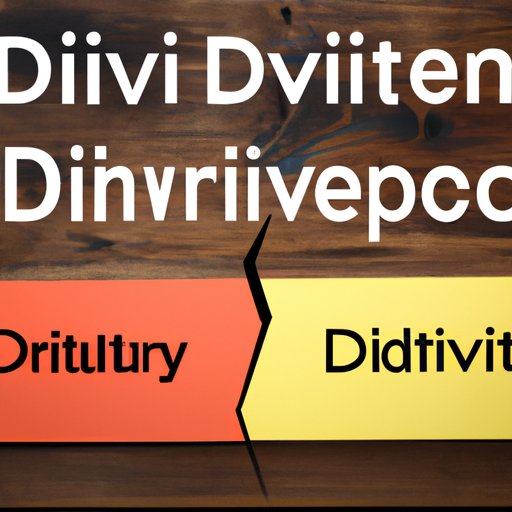Introduction
A divorce is the legal dissolution of a marriage by a court or other competent body. It is typically a difficult and emotional process, but it is important to understand the laws and procedures related to divorce so you can make informed decisions. This article will provide an overview of how a divorce works, including the different types of divorce, the role of attorneys, property division, child custody and support, mediation, and tips for navigating the process.

Overview of the Divorce Process
The first step in a divorce is filing the appropriate paperwork with the court. Depending on where you live, this may be done online or in person at the courthouse. Once the paperwork is filed, there is usually a waiting period before the court will grant the divorce. During this time, the couple may attempt to reconcile. If the couple cannot reconcile, then the divorce process continues.
Next, the person who filed the papers must serve them to the other spouse. This is typically done by a process server or sheriff’s deputy. After the papers are served, the other spouse has a certain amount of time to respond. If the other spouse does not respond within the specified timeframe, the court may issue a default judgment, which grants the original filer’s requests without input from the other spouse.
Once the paperwork is filed and served, the couple may attend court hearings to resolve any outstanding issues. These hearings may include temporary orders, such as spousal support and child custody, as well as permanent orders, such as property division and the final divorce decree. The court may also appoint a mediator to help the couple come to an agreement on any unresolved issues.
Explaining the Different Types of Divorce
Divorces can be either no-fault or fault-based. In a no-fault divorce, the couple agrees to end the marriage without assigning blame or fault. This type of divorce is often quicker and less expensive than a fault-based divorce. A fault-based divorce requires one party to prove that the other party was at fault for the breakdown of the marriage, such as through adultery, abuse, abandonment, or other grounds.
In some states, couples can opt for a summary divorce if they meet certain criteria. This type of divorce is typically faster and less expensive than a standard divorce because it involves limited paperwork and fewer court appearances. Typically, summary divorces are reserved for couples who have been married for a short period of time and do not have any children or significant assets.

The Role of Attorneys in a Divorce
An attorney can play a key role in the divorce process. First, it is important to retain an experienced divorce attorney who understands the laws in your state. Your attorney can help you understand the process and ensure that your rights are protected throughout the proceedings. An attorney can also help you negotiate with your spouse and make sure all paperwork is completed properly.
When working with an attorney, it is important to be honest and open about your situation. Be prepared to provide your attorney with detailed information about your finances, assets, debts, and children. This will help your attorney build a strong case on your behalf. Your attorney can also provide advice on strategies to protect your rights and interests during the divorce process.
Hiring an attorney can be beneficial in many ways. An attorney can provide valuable legal advice and representation in court. They can also help you negotiate a settlement that is fair and in your best interests. Additionally, an attorney can reduce stress and save time by helping you navigate the complex legal process.

Understanding Property Division During Divorce
Property division is an important part of the divorce process. In most states, the court will use the principles of equitable distribution to divide marital assets and debts. This means that the court will try to divide the assets and debts in a fair and equitable manner, taking into account the parties’ financial situations and other relevant factors.
In community property states, the court will divide all assets and debts acquired during the marriage equally. This can include real estate, personal property, bank accounts, investments, retirement accounts, and more. Each party is responsible for their own premarital assets and debts.
In addition to dividing assets and debts, the court may also decide on spousal support. This is a payment made by one spouse to the other to help support them during and after the divorce. The amount and duration of alimony depends on the couple’s circumstances.

Child Custody and Support During Divorce
If the couple has children, the court will also decide on child custody and visitation rights. The court may award sole custody to one parent or joint custody to both parents. In either case, the court will consider the best interests of the child when making its decision. The court may also order the non-custodial parent to pay child support to help cover the costs of raising the child.
Visitation rights are also determined during the divorce process. The court may order supervised or unsupervised visitation, depending on the circumstances. Visitation schedules should be created to minimize disruption to the child’s daily life and give each parent adequate time with the child.
Mediation and Other Alternatives to Court Resolution
Mediation is an alternative dispute resolution process that can be used to settle disputes in a divorce. During mediation, a neutral third-party mediator helps the couple come to an agreement on unresolved issues, such as property division and child custody. Mediation is often less expensive and quicker than going to court, and it allows the couple to maintain control over the outcome.
In some cases, couples may also choose to pursue other alternatives to court resolution, such as collaborative law or arbitration. These processes allow the couple to avoid litigation and work together to reach a mutually satisfactory agreement. It is important to understand the differences between these processes and how they can affect the outcome of your divorce.
Tips for Navigating the Divorce Process
Navigating the divorce process can be overwhelming and stressful. Here are a few tips to help you get through it:
- Remain organized. Keep all documents and correspondence related to the divorce in one place.
- Make a plan. Create a timeline for each step of the process and keep track of deadlines.
- Seek professional help. Retain an experienced divorce attorney to help you understand the process and protect your rights.
Conclusion
Divorce is a difficult and emotional process, but understanding the laws and procedures can help you make informed decisions. This article provided an overview of how a divorce works, including the different types of divorce, the role of attorneys, property division, child custody and support, mediation, and tips for navigating the process.
(Note: Is this article not meeting your expectations? Do you have knowledge or insights to share? Unlock new opportunities and expand your reach by joining our authors team. Click Registration to join us and share your expertise with our readers.)
